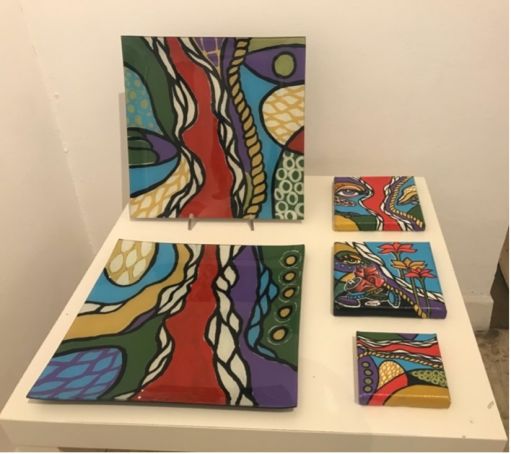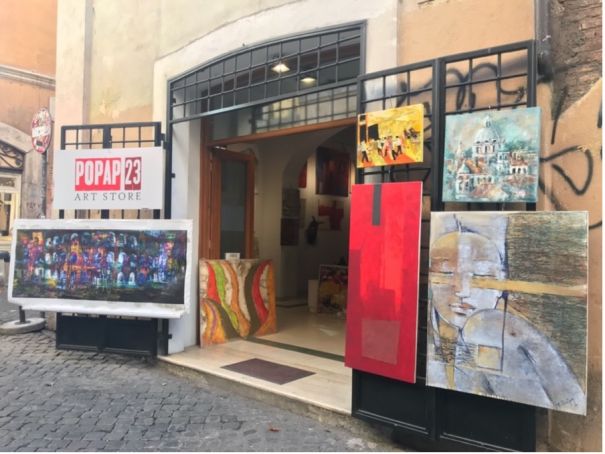How Art Galleries and Artists are Surviving the covid-19 crisis in Rome
The Slow agony of an artless Rome.
by Marilù Ciabattoni
If surviving the pandemic was a challenge for big museum workers, for private gallery owners and local artists it has been a death sentence.
Picture this: it’s 2019 and Rome is full of art stores and local artists painting on the street—maybe a nice vicolo in Trastevere or an iconic building like the Coliseum—to then exhibit their work in some piazza—like Piazza Trilussa or Piazza Navona. In Via di Monserrato, near Campo de’ Fiori and Piazza Farnese, you could see private galleries at every corner, free to visit for any passer-by captured by the shiny and colorful artworks displayed.
Also read: Guide to contemporary art galleries in Rome
A year later, the atmosphere is almost completely different.
17 November 2020
After the d.P.C.m. of Nov. 3, the Italian government decides to close museums and exhibitions until 4 Dec. This decree does not include private galleries, considered commercial spaces. However, the fact that these institutions can stay open does not necessarily mean they have nothing to fear—financially speaking.
Spazio40

2020 hasn’t been the easiest year for the founders of a small art store located in via dell’Arco di San Callisto 40—hence Spazio40. The owners—a business and real-life couple—created this store around ten years ago with the goal of giving visibility to up-and-coming artists, organizing around 170 exhibitions around Trastevere and Rome. One of the owners, Fabrizio, is saddened by the climate that the pandemic created, calling Trastevere “a dead neighborhood.”
Fabrizio opened Spazio40 in 2012 with his partner Tina Loiodice, with the idea of turning it into her atelier. A versatile artist and artisan, Tina knows the hardships an artist must endure in the contemporary market. Described as multi-purpose, the gallery’s mission was to discover rising local artists by renting the walls of their gallery at an affordable price. After the first year of activity, they attempted to organize some solo shows and group shows which turned out to be very successful, a satisfaction for the two founders who had many aficionados among the artists that regularly visited the gallery.
Their project continued successfully until 2020. It’s with deep sadness in his eyes that Fabrizio announces the difficult decision they were forced to make.
“In just a few months, everything fell apart because of what happened. As a consequence, we are closing on 31 December.” He remembers how Trastevere used to be so dynamic and inspiring, comparing it to its current conditions—bars and restaurants closed, no tourists, no night life, no artists painting down the street. “Yet, I’m still hopeful because I’m in love with Trastevere and seeing it like this… Mi piange il cuore,” he admits in his romanaccio. It’s painful for him.
Fabrizio and his partner cannot suffice economically to anything: sales are low and organizing exhibitions wouldn’t be profitable, considering small number of people that would attend. That’s when they started wondering, why are we still here? And, more importantly, for whom? It’s a question they kept asking themselves throughout the year, until they became one of the few art institutions in Trastevere that refused to give up.
“Io preferivo, ti giuro, preferivo che mi dicessero devi sta’ chiuso. Almeno non vedevo questa agonia lenta,” he says in the authenticity of his Roman accent. He’d rather keep the shop closed, to avoid witnessing this slow agony that is taking over the world.
Also read: Up to date news about covid-19 in Italy
But was this choice inevitable? Is there anything that we as a society could have done to prevent the situation? Fabrizio has a very strong opinion about this: after the first lockdown, people mistakenly understood that the worse phase of the pandemic was behind us and that everyday activities could resume safely. Including clubbing, where most of the second wave originated from, and which then exploded when school opened again.
The government wasn’t even considering the possibility of a second wave, and now that it is currently happening, they cannot afford to support people economically. The 600 euros Fabrizio—like many other Italian workers—received back in March are not enough to pay the gallery’s bills. In countries like Germany, the government paid the rent of small institutions like Spazio40 for the entire period they had to stay closed. However, Fabrizio explains, German economy is in a much better standing than Italy’s. Italian economy wasn’t good before the pandemic and now it’s even worse, he thinks.
Italy, the country whose art and culture is celebrated all over the world, was failed by its government, which didn’t do enough to help small art spaces like Spazio40. “Although things will get better when we have a vaccine, the drama of unemployed people will continue. We will go back to normal but not the way it used to be. We can never go back to what it was before,” Fabrizio says.
And this is when he brings up the main problem: the lack of tourists, particularly essential in a neighborhood like Trastevere. “Foreigners have a different art education,” he explains. Ironically, although Italians should be the culture that exports art all round the world, in reality other nationalities have a more careful attention to artistic expression, which is why, in months of frequent tourism, 9 out of 10 people who enter the gallery are foreigners, he says. “For the average Italian, art galleries are not a place to be in,” he chuckles, bitterly. Then, a pause.
“This is sad,” he concludes.
23 November 2020
I’m in Spazio40 again. This time, Tina is here with Fabrizio. With them, another artist, who soon leaves us to pick up her phone outside.
Tina feels just like Fabrizio does: they could’ve survived one or two months—even three—of sacrifices, but the idea of supporting the store with the uncertainties that the future brings is unbearable. Still, Tina, who created graffiti all over Rome and in the Viterbese region, knows she will not give up on her profession—this passion, this art-making in all its forms. Hopeful, she calls it an “evaluating period, hoping that things will go back to normal, since we’ve quite lost the sense of normalcy.” A pause.
“We’ll see as time goes by,” she continues. “If this space is still available—which I truly hope. Or we’ll find other opportunities.”
For galleries and theaters—or any other art form—there hasn’t been any consideration nor attention. They didn’t have any help nor regulations that would allow them to continue their activity. Especially in Rome, where art is an essential aspect of everyday life. It’s not sustainable in the long run. They are on their own, which means that, no, we are not in this together, after all. And no, non andrà tutto bene—it’s not going to be okay.
Also read: Best museums in Rome
To ease the conversation, she points at a canvas near the entrance and starts telling the story behind that piece of art: she and other artists created it during a manifestation where they did not have available walls to paint on. The task became more challenging when it started raining, after which the paint started dripping from the canvas, which currently stands as the chronicle of the story.
Despite the current hardships, she considers herself lucky—almost privileged—to have or have had her own space where she could exhibit her works. However, she still recognizes the big role that the internet is playing nowadays.
“We, as artists, are all indispensable in the evolution of the contemporary art market. The internet is helping us, but it can never become the alternative.” She mentions the “feel of galleries” that cannot be substituted by an online exhibition or a digital guided tour.
“I just hope it will not substitute the experience you can only have by visiting a real gallery,” she concludes, while the other artist is entering the shop again. Tina greets her with a “Ehi Za’! Esprimiti anche tu,” inviting her to express herself.
The other artist’s name is Zaire. Originally from Venezuela, she moved to Italy with the hope of creating a new life for herself.
“For me it’s a sobrevivenza,” she says, half in Italian and half in Spanish. An act of survival. She explains that they’re trying to maintain a positive attitude but, like any other people, they also have taxes to pay, children to feed. Although their job may not be considered essential, it is still important because, without culture, a country cannot go on. “But unfortunately,” she continues, “when people need to sobrevivere, they need a warm home, food, …”
“Other priorities,” Tina adds.
“A me me ha afectado anche emozionalmente,” Zaire says. The situation affected her emotionally. As artists, they made this very difficult choice of making a living out of it, without a backup plan. They simply do this job because they love it. Zaire cannot find the right words to express how she feels.
Saving her from hesitation, Tina adds that, in the twelve years they have run the gallery, they could never afford closing, not even for vacation. This is not just real love. This is a marriage. A sacrifice that they do willingly. “Because if you love something you do whatever is in your power to keep it alive, no?” Zaire says.
She calls it un eschiafo—a slap—what happened to them. Something that took away a piece of them. She is currently considering reducing the expenses of her studio in Testaccio. Otherwise, she’ll have to leave, although she cannot go anywhere else. “They’re taking everything away from us, and I don’t think we will have it back that easily,” she says. “People say andrà tutto bene but…”
Fabrizio chuckles from the back of the store.
“… but how can I sobrevivere in the meantime? Before we have a vaccine?” she asks. She feels like she’s on the edge of a cliff, hanging on the few things and people that can help her. There’s one thing she and Tina can agree on: nothing is certain and being an artist is becoming scarier as the future becomes more and more precarious.
She repeats it one more time. Es un eschiafo. A slap that they weren’t ready to receive. A slap they didn’t deserve.
She talks about Venezuela, her native country where she cannot live anymore. If she cannot live in Italy either, is she supposed to move to a different planet? She has made a living for herself here. Her grandson was born here. Nine years of hard work and yet another obstacle. “Che devo fa’? Dove vado? I can try and sobrevivir otherwise me ne devo andà.” She either survives or she’ll have to leave.
It’s a hard situation for everybody, but for some type of workers it’s even harder, Zaire thinks. People still don’t understand that art is a job. That they worked years and years to develop their technique and aesthetic, just to make people understand the immense effort behind every piece. To make people take you seriously. It’s hard. Extremely hard, she repeats.
“Still, we’re here. Fighting. And resisting. And this is the truth,” is the last thing that Zaire says.
The only artistic space that is still carrying on Trastevere’s dying art scene is Popap 23, located in Via del Moro, one minute from Piazza Trilussa.
Popap 23 in Trastevere

It’s a rainy mid-November afternoon.
The three artists sit on a circle and I ask them to introduce themselves. On the left side of the space, Armando Di Loreto. Behind a wooden table where he is occasionally touching different pieces of cloth, Daniele Colaiacomo. Finally, on the right side, Nicola Bucci or “Bucnic,” crossing his arms on his chest. They seem relaxed. They talk like old friends spending their retirement days at a bar.
Also read: Visiting the Vatican Museums: All You Need to Know
Daniele explains this place is being cyclically rented to artists so that they can display their artworks: six artists like the six walls of the space, each of them expressing their past and present experiences with different styles and techniques.
They share their experience during lockdown: while it wasn’t the easiest for Armando, who found it impossible to express himself, Daniele was very productive as a result of being forced to stay in his studio for months.
Nicola hardly speaks: he keeps looking at the floor as if he cannot hear or doesn’t want to hear. And then, he makes his first intervention.
He says he hurt his knee during lockdown, so that he had to stay home whether he wanted it or not. He then resumes staring at the floor like he has been doing all along.
Daniele, who previously owned an art gallery not so far from where they are now, mentions the lack of foreigners, with whom they had more opportunities, commercially speaking. He remembers when they would exhibit in Piazza Trilussa on Sunday mornings, giving a colorful touch to the already pleasant environment of Rome, a city based on tourism.
Outside, the rain is heavy, and the door is wide open. They raise their voices a bit.
Also read: Rome's Botanic Garden: a semi-forgotten wonder
One by one, they point at their own wall displaying their artworks: Daniele brought his abstract pieces and one figurative painting; the silent Nicola says he works with different genres without elaborating; finally, Armando says he works with mixed media and photography defined with paint, or, as he simplifies, “pop art.”
Nicola gives his third contribution to the discussion. “Six artists of the association we are part of will be featured in an exhibition promoted with the patronage of the Istituto Italiano di Cultura at the Columbus Center in Toronto, Canada next October.”
“We are the associazione culturale Escidicasa, an association for 100-120 painters whose work focuses on Rome,” Daniele adds.
“We are the first representatives of Confusionismo, which is also the title of the exhibition,” Nicola says. “You are talking to the founders of this new artistic movement,” he says, halfway between joking and being serious—an ambiguity that makes his statement even more interesting.
“This movement will come out sooner or later. We don’t have a manifesto yet, but we will soon” Armando adds. “You’ll see.”
17 November 2020
The rain of the day before is gone. Same space, different artists.
Elisabetta says she’s shy. I tell her not to worry, that I just wanted to have a conversation with them. Loredana’s dog is jumping all over the place, barking occasionally.
Loredana has been painting since 2006.” Her ‘rs’ are delicate, almost non-existent. Her dog keeps frenetically moving around as she occasionally scolds with a fermo!
“I started by making artisanal work, but then I went to Scuola di Alti Mestieri in San Giacomo, after which my career as a painter was born,” she says.
Also read: Rome airports - All you need to know about Fiumicino and Ciampino
She says covid-19 hasn’t really affected her painting style: she is still expressing her joy of life, colors, happiness, nothing too interiorized nor related to the current situation.
“I wouldn’t even know how to express pain,” she confesses. “All the works you see here,” she points at her wall, “they were all painted this year.” To her, art is a therapy that brings serenity and harmony.
“Per me non è cambiato niente,” she concludes, saying that nothing has changed for her, at all.
Now it’s Elisabetta’s turn, her face partially covered by her surgical mask.
“I’ve been painting professionally for 4 years. Before that, I was already making art, but I had never exhibited anything. Then I joined the Escidicasa association and I started exhibiting on the street and in squares,” she says.
She points at the wall behind me—her wall. “I like to work on faces and geometrical elements that break the figure. I also focus on the figurative aspect of my art, like these big faces you see here,” she explains.
Also read: Rome's most beautiful fountains
She talks about what lockdown meant to her: she had problems painting, just like Armando. Unlike Loredana, the changes did prevent her from expressing calmness in her artworks. Then, slowly, she regained all these elements that make her art unique.
Although Loredana and Elisabetta consider themselves lucky because they can still exhibit, their relationship with the public has become more difficult, mainly due to social distancing protocols. Add to that that people do not buy as many paintings as they did before.
Elisabetta starts saying that many of their buyers used to be foreigners when Loredana interrupts her. Tourists have a different approach, she says. An artwork purchased in Rome is not a simple souvenir. They are not afraid of going inside a gallery and admire the artworks.
Italians, on the other hand, are afraid, almost intimidated to do so. Just like Fabrizio had mentioned. For the average Italian, art galleries are not a place to be in.
The Italian government is shamelessly neglecting the workers that are essential for Italy to maintain its centrality and reputation of cultural capital: the artists. As Zaire said, you either survive or you disappear. It doesn’t matter for how long, because not enough Italians are educated about contemporary art to notice. As Fabrizio said, it’s sad, but it’s the truth.
---
A heartfelt thank you to the artists that have participated in this article, in the hope that they will continue expressing their art even in these uncertain times (in no particular order):
Daniele Colaiacomo: www.danielecolaiacomo.com
Armando Di Loreto: @armandodiloreto
Nicola “Bucnic” Bucci: www.nicolabucci.com
Loredana Giannotti: @loredanagiannotti
Martinez Elisabetta: @martinezelisabetta
Fabrizio Ena & Galleria d’Arte Spazio40: www.spazio40galleria.it
Tina Loiodice: @tinaloiodice
Zaire Torrealba: www.facebook.com/zarturbanstudio
Interviews translated from Italian by Marilù Ciabattoni
Image credits: Marilù Ciabattoni / All Rights Reserved

















